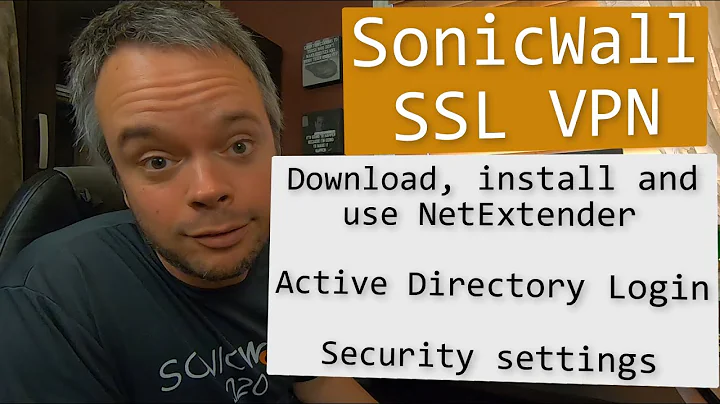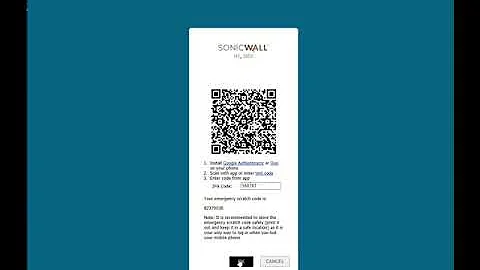Authenticate VPN with Active Directory and Sonicwall TZ 200 Device?
You might consider running RRAS + PPTP on your Win2k8 DC and just forwarding the necessary ports through. It's much, much easier to do access control from within AD that way. That's how my company set it up and it works very well. YMMV.
Related videos on Youtube
cisellis
Product and Portfolio Manager. Husband and dad, sports and music lover, coffee required.
Updated on September 18, 2022Comments
-
 cisellis over 1 year
cisellis over 1 yearThe context for this is that I am not a systems administrator but I'm doing my best, so please be patient with me. :)
The end goal is that we would like users to be able to VPN in and access network resources, through our Sonicwall TZ 200 device, using their Active Directory credentials.
Some notes:
- Currently, our Sonicwall device is running the latest version of the SonicwallOS firmware.
- The Sonicwall VPN was set up to use Local Users + RADIUS and was working fine. The local users have been set up as "userABC" with a shared key and are able to connect using the basic Windows or Mac vpn clients and then access resources behind the firewall.
- The Active Directory box is set up with internal domain "internal.specialsuperdomain.com" and we can add users and boxes to the domain from inside the firewall. No problems there.
- We just set up the SonicWall LDAP settings to integrate with our internal Active Directory controller. I can authenticate the user "[email protected]" on the LDAP integration test page.
- Every time I make changes to the LDAP integration on the Sonicwall, I get a warning from the Sonicwall device that the L2TP server is setup using CHAP, which is not supported by Active Directory. I think this is where my problem is. When I change the user settings to "LDAP + Local Users" and the user tries to VPN in using their Active Directory credentials, they receive the a failure to authenticate error (tested on a Mac) and the SonicWall logs a dropped packet due to "IP Spoof Detected" error from that user.
I've thought maybe I needed to do something with LDAP + Radius to bridge the gap between the VPN and the Active Directory, but I'm not sure. I'm going through all of the Sonicwall documentation I can find but I'm not seeing anything so far that helps. Any tips or ideas? How should I set this up?
UPDATE: Our domain is set up at "Windows Server 2008" functional level. We were not able to authenticate from the Sonicwall using the pre-windows-2000 format "domain\username", I presume because the domain is not set to Windows Server 2003 functional level. We are able to authenticate from the Sonicwall using the updated full usernames ("[email protected]") and so we have been trying to authenticate to the vpn the same way.
-
 cisellis about 13 yearsWhen we were using Local Users + RADIUS, we used "username" and created the user on the firewall. For Active Directory, we are trying to use the post-Windows-2000 compatible username, [email protected]. Our Domain is set up to "Windows Server 2008" functional level and I have not been able to authenticate users from the Sonicwall using pre-windows-2000 compatible usernames ("domain\username").
cisellis about 13 yearsWhen we were using Local Users + RADIUS, we used "username" and created the user on the firewall. For Active Directory, we are trying to use the post-Windows-2000 compatible username, [email protected]. Our Domain is set up to "Windows Server 2008" functional level and I have not been able to authenticate users from the Sonicwall using pre-windows-2000 compatible usernames ("domain\username").
-
 cisellis almost 13 yearsThis is actually what we ended up doing, letting W2K8 manage it all. It's working much better for us as well.
cisellis almost 13 yearsThis is actually what we ended up doing, letting W2K8 manage it all. It's working much better for us as well. -
John Galt almost 13 yearsReading through my answer, I said to run RRAS on your DC. In reality, you shouldn't do this as it multihomes your DC. This is OK (but still not ideal) if you only have a single DC, but if you have two or more, you'll run into problems. Run it on a non-DC and it works very well.
-
 gravyface about 11 yearsPPTP is pretty terrible. Have a look at IPSec/L2TP at the very least.
gravyface about 11 yearsPPTP is pretty terrible. Have a look at IPSec/L2TP at the very least.




